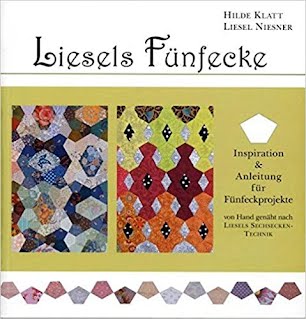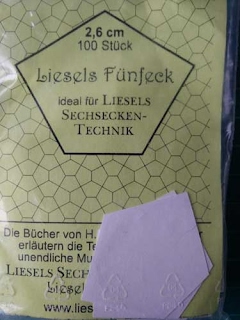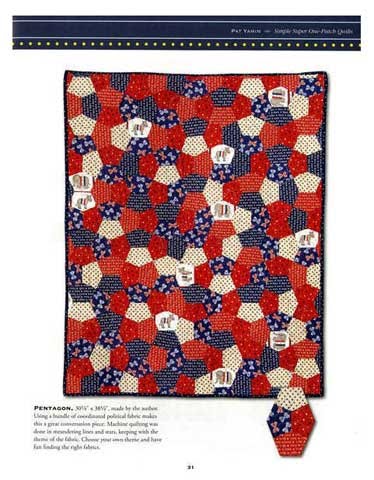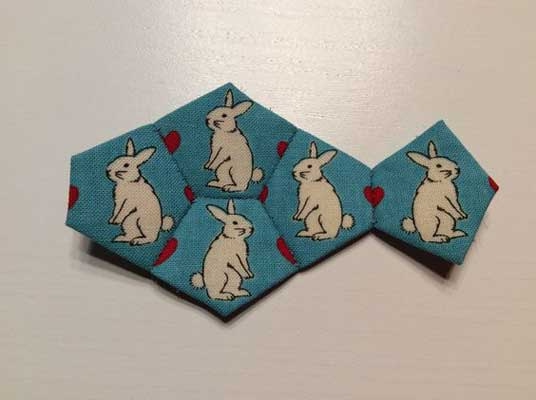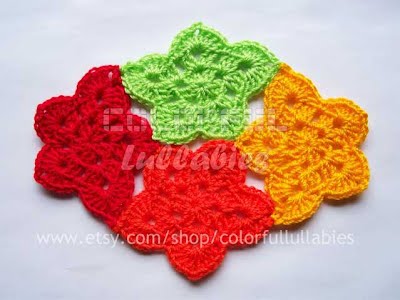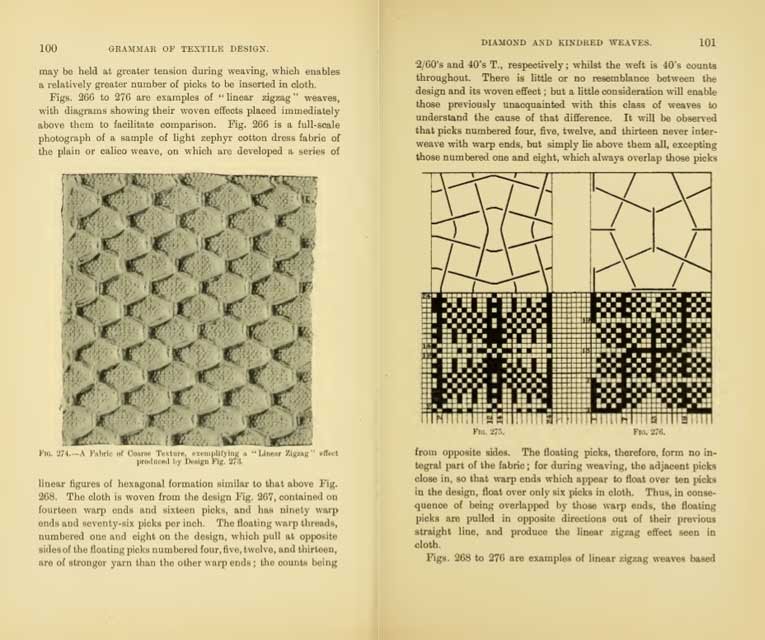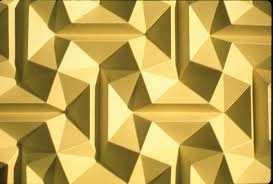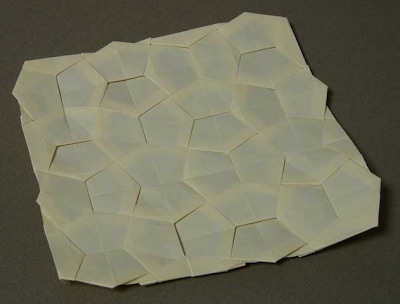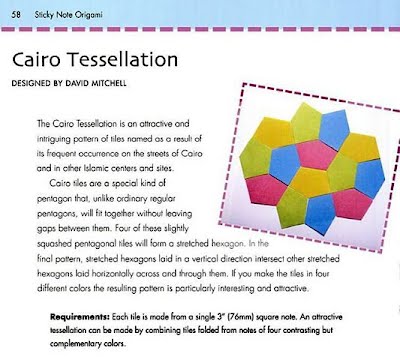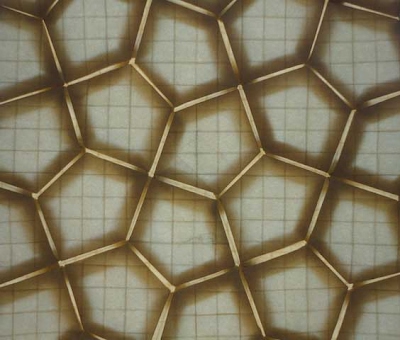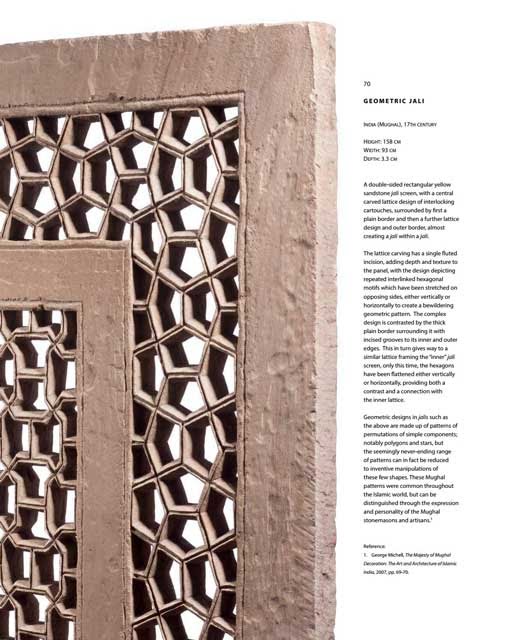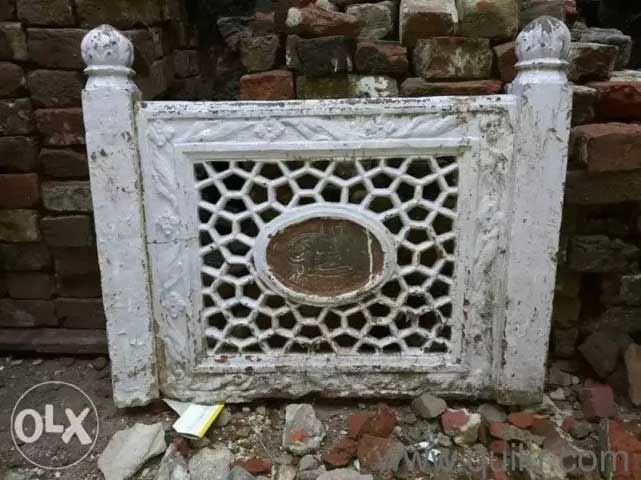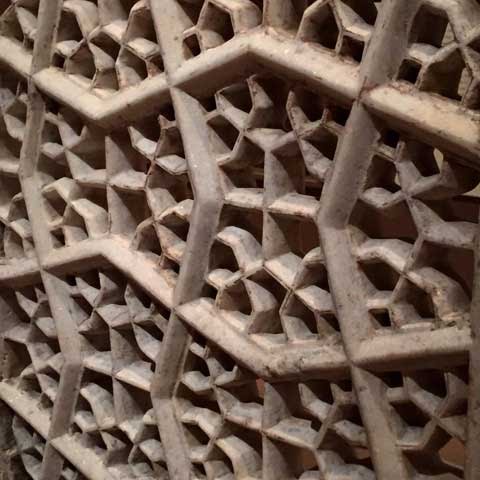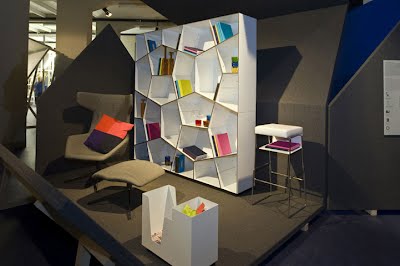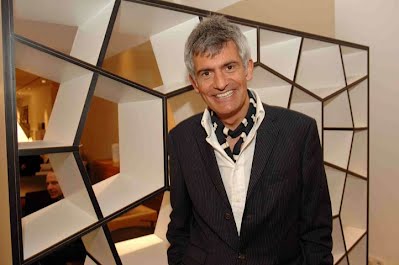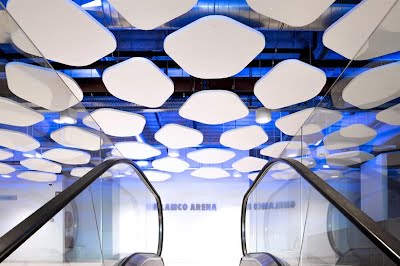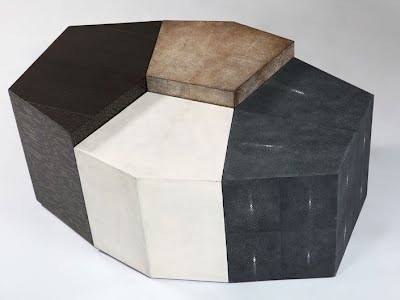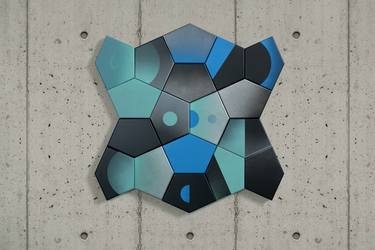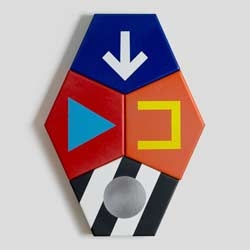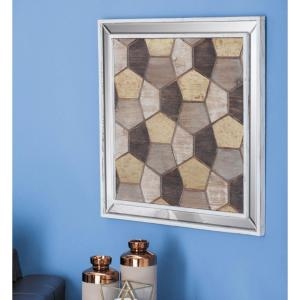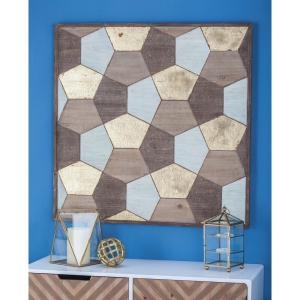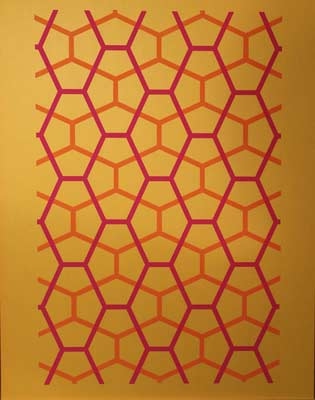Under Rearrangement 6 December 2019+ A continuation of the Cairo Tiling 'as' theme, with upon having distinct, dedicated sections for extensive architecture, flooring, paving and wall tiles applications, I now turn my attention, to what I term as miscellaneous entries. As the title implies, this is a non-dedicated section, of a wide range of such miscellaneous entries. As such, I differentiate these into two categories, 'major' and 'minor', as Miscellaneous 1 and Miscellaneous 2. Miscellaneous 1 consists of entries that have 3 or more from a single entry, whilst Miscellaneous 2 is of two or fewer. The criteria is somewhat arbitrary, with the cut-off point judged to result in roughly equal length pages. This is for the sake of a more digestible page. Previously, at least of the last incarnation, the entries of Miscellaneous 1 and Miscellaneous 2 were of a single long extensive page, which with ad hoc additions had become a little disjoint and unwieldy. This separation into distinct entities thus results in a more orderly arrangement and page. by the very nature this study is in a permanent state of flux, as I find time to research, add to the page and on occasion add sightings sent to me by correspondents.The entries are ordered as by the frequency of instances, with the more numerous first. A miscellaneous, largely ‘for fun’ collection of various non in situ Cairo tiling aspects, in which the Cairo tiling is to be seen in a variety of objects and applications. The format for each entry is initial outline, a picture and discussions, ending with links. On occasions, I am unable to show pictures as the image holder did not respond to request for permissions, and where this arises I thus instead give a link. Does anyone know of other instances? Do let me know for inclusion. The instances include: 10 8 3 Fibre Arts - Introduction A collection of what I term as ‘fibre art matters’, with instances of patchwork, quilts, crochet, paper piercing and weaves. Arguably, given the premise of distinct topics of the page, some of these would be better placed as district entries, but for the sake of a related, themed ordering I thus place as an entity. As such, I am a little hamstrung in my investigations as to fibre arts, as I am effectively an outsider to the field. I have only studied this as regards patchwork in the context of tessellations, primarily in 1987, at the beginning of my interest in tessellation. As such, I have not returned to the study since, having essentially taken what I wanted from the field, and moved on to other matters. Since my initial interest, books have appeared especially with a tessellation premise, such as Tessellation Quilts by Christine Porter and others, albeit I have not pursued these. Even with a tessellation interest here, likely this situation will continue for the foreseeable future, if not forevermore; I have more than enough to be getting on with my ‘normal’ studies, without starting on new fronts! Like most subjects, there is more to this than appears at first sight, with different materials, procedures with distinctions between quilting and patchworks, of which I was largely unaware of before this research. And likely other aspects too that I have not yet encompassed. Therefore, all this should be borne in mind with my analysis. There are many sites and pages on fibre art regarding the Cairo tiling, of varying degrees of interest and usefulness to me. Fibre Arts 1 - Quilting/Patchwork, by Josée Carrier An instance of quilt work by Josée Carrier, of Canada, titled ‘Cosmic Voyage’,18″ x 36″, as shown on her website ‘The Charming Needle’. This work was created in response to a design challenge fabric contest on Spoonflower (an on-demand, digital printing company that prints custom fabric) in 2014, with the theme of ‘Cosmic Voyage’. However, upon submission, it didn’t reach any further than this initial stage. This is described as: When sketching some ideas, I thought of joining some blocks to form a space ship. When playing with different shapes, I found that it worked out quite well using pentagons for the blocks… The idea was to use the other pentagons as windows on different things you can encounter in the immensity of the cosmos: nebula, galaxy, solar system, planet with craters. I put a lot of work and learned a lot from doing the 4 different designs for the pentagons…  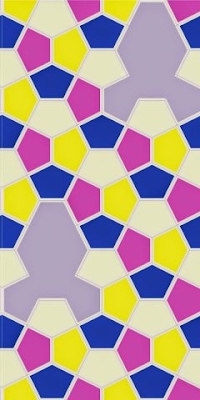 Josée Carrie I contacted Carrier, in 2014, to ask her about this, and found her most friendly and helpful. She told me that my site as the inspiration! She was previously unaware of the Cairo tiling, and found it ideal for her project: … When I started working on my fabric design. I was looking for a tile that could be assemble to form a spaceship. I thought it would be different using a different shape like a pentagon. This is when I started looking around on the internet and found your site. When I saw the Cairo tiling, I thought that was it. As soon I started making some sketch, I found out it was perfect for making a spaceship... Background Carrier has an engineering background, but also has a decided arts and craft interest, with sewing and quilting, and so she thus combines her interests to a common purpose. She has published several sewing and quilting projects in different magazines and is the co-founder of the Montreal Modern Quilt Guild. Her website is titled ‘The Charming Needle’. http://thecharmingneedle.com/2014/06/cosmic-voyage.html http://www.spoonflower.com/designs/3339792 Fibre Arts 2 - Quilting/Patchwork/Paper Piecing, by Hilde Klatt and Liesel Niesner An instance of quiltwork/patchwork/paper piecing, in the German book Liesels Fünfecke: Inspiration & Anleitung für Fünfeckprojekte von Hand genäht nach Liesels Sechsecken-Technik, published by Ildico, 2006, by Hilde Klatt and Liesel Niesner. This translates as Liesels pentagons: Inspiration & Instructions for Pentagon Projects Sewn by Hand According to Liesel's Hexagonal Technique. This is described as: 228 pages of continuous color illustrations 32 new pentagonal line drawings as a design template … Hand sewing the grandiose pattern of Liesel's pentagons opens up a veritable treasure chest. In this rich book you will find more than 50 projects, from quilts to little things to murals. There are detailed instructions for reworking, many suggestions for variation, as well as inspiration and encouragement for your own designs. Liesel's pentagons are irregular pentagons that can be joined together to form a flat surface. The patterns are divided into the three sections... Book Cover, left; Pages 176-177, middle; Templates, right Ildico is associated with Hilde Klatt’s blog, and so it appears to be a self-published book, although not of the typical vanity type, as it is widely quoted. There also appears to be templates available arising from the book.
I have not been able to establish if there is a mention of the tiling in the book. Certainly, pp. 176-177 do not mention the association. Therefore, whether the use of the Cairo tiling is purposeful or accidental, the latter in the sense of a generic pentagon tiling is unknown. Having not seen the entire book, it would be unfair to speculate, but likely, given their background, they would be not familiar with the association. Aside from a strict Cairo tiling, instances are also shown of a Cairo tile in association with other polygons, on the front and back covers, and inside. And indeed, some are most interesting!
Klatt and Niesner have also authored another earlier book, of 2001 (of which the above book title alludes to), on hexagons, in the same style (with an English translation). Liesels Fünfecke thus obviously builds upon the success of the earlier book. I did not contact either of the authors.
Background Details Surprisingly little is known of Klatt and Niesner themselves. Indeed despite a website (Niesner) and blog (Klatt), there is next to biographical information on them at all! That said, Klatt’s blog is indeed expansive and she describes herself as: … designer and author, with a passion for color, form and textiles... The website, which serves to market the book, is very poor indeed, and is barely functional, although the book is indeed described relatively well.
http://www.liesels-ecke.de/ (A portal to Lieselei online store and HiIdes Ildicolor blog) https://www.shopssl.de/epages/es101247.sf/de_DE/?ObjectPath=/Shops/es101247_Liesels-Shop/Products/01189036 (Shop) https://ildicolor.wordpress.com/2012/09/22/shells-muschelquilt/ (pp. 176-177 of the book) https://ildicolor.wordpress.com/2012/09/22/shells-muschelquilt/ (pp. 176-177 of the book) The following are all quilts derived from the book, with the maker’s name in brackets: https://www.patchwork-quilt-forum.de/fuenfeck-decke-t4768.html (‘Maria’) https://domesticat.net/2015/08/new-pentagon-in-town (Amy Qualls) http://bastiansoma.blogspot.com/2010/06/5-eck-fieber-fische.html (‘bastiansoma’) https://klaudiaspatchwork.blogspot.com/2017/10/mein-sommergarten-quilt-3-blume.html (Klaudia Schumacher) Fibre Arts 3 - 'Quilt', by Christiane Bettens, aka Mélisande An instance of ‘quilt’, titled ‘Cordovan pentagon quilt (opus XLV)’ by Christiane Bettens, aka Mélisande, an origamist, albeit included here with considerable reservation. Quite how best to assess, or interpret this instance is unclear: is it origami, quilt or a combination? I have decided to discuss under both. Here I discuss as a quilt. Indeed, a convincing case can be made for placing solely as origami, which much better describes this instance. Indeed, it is not a quilt at all (despite the initial impression of a quilt-like interior decoration), at least in the conventional sense! However, I have thus included here for the sake of thoroughness (and indeed place what I consider as a more proper placing as origami in that section as well). Curiously and confusingly at first glance to the non-origamist, Mélisande also has other works she titles as quilts, despite plainly (without the suggestive quilt-like interior decoration of the Cordovan instance) being origami! To the outsider of origami, as I was, this description at face value appears to be a quirk of Mélisande’s. However, I now see that this is an ‘official’ description of the origami world, and is freely used, and indeed there are books with the title. The Origami Resource Center gives: Given that origami has been around for over a thousand years, origami quilts is a relatively new branch of origami. Here, paper is folded into units and many units join to form beautiful, planar mosaics. These can then be displayed on a tabletop or hung up against a wall. Origami quilts may be considered a subset of modular origami. In modular origami, the models are usually polyhedra or stars. In contrast, origami quilts are flat and, in principle, can expand indefinitely. Because origami quilts are composed of many units joined side by side, they are reminiscent of tessellations. So there you have the explanation! Mélisande is aware of the Cairo tiling and directly refers to it as such, albeit briefly: Cordovan pentagon quilt (opus XLV) Inspired by Oschene's Cairo pentagonal knot. Angles of these pentagons are 135° 90° 112,5° 112,5° 90°, same as figure 3 on this page. So the cordovan is considered a subspecies of the cairo tiling. (Actually I found the reference after creating the unit myself) 71 pieces ‘Oschene’ is her friend, Philip Chapman-Bell. From her comments, the Cordovan attribution appears to have been applied retrospectively. This is the only instance in her origami/quilt work. I did not contact Mélisande. Background Details Christiane Bettens/Mélisande is prominent on Flickr, and has an extensive blog, ‘The Chronicle of Mélisande’, both under Mélisande (the explanation of the nom de plume is not given), albeit, and curiously, without any mention of her real name (and which initially hindered research)! She first became interested in origami in 2003 and has a tessellation interest. She comes from a family with a paper tradition, editing, printing, selling paper, but she did another choice for a profession, a primary care physician. https://www.flickr.com/photos/melisande-origami/7328846506 (Cordovan pentagon quilt (opus XLV)) https://www.flickr.com/photos/melisande-origami/albums/72157631972891733 (Cordovan quilts) https://origamiusa.org/thefold/article/origami-designers-secrets-christiane-bettens-m%C3%A9lisande (Interview) http://origami-art.org/blog/index.php?post/2008/01/01/3-about (About) Fibre Arts 4 - Quilt, by Lynn Kline, ‘Monkey Needle’ An instance of quilt work by fibre artist Lynn Kline, of the US, as shown on her website ‘Monkey Needle’. This work was created in response to a ‘challenge’ of sorts, of an ‘adventurous’ nature, of a quilt without the typical geometrical shapes normally encountered in quilting, such as squares, triangles and hexagons. Pentagons, as regards the practical aspects of sewing, are a somewhat ‘awkward’ shape to incorporate into a quilt (which explains the decided paucity of them in this field). The quilt is described: But I don’t remember ever seeing a quilt made with pentagons… Then I found a picture of a pentagon bookcase and the idea for this quilt was born. On the top half of the quilt, the colored blocks and pieces are supposed to look as if they were sitting on a shelf of the bookcase. So the blocks are stacked, the books are laying at an angle, and the flower arrangement is lying on an angled shelf but not at the very edge. The bookcase, from the link given, can be seen to refer to the Quodes/Alfredo Häberli instance (see the bookcase section), although this is not stated as such. A pleasing feature is the ‘interior within’, with books and flower decorations adorning the shelves. The quilt, apparently of 2014, mimics the different sizes of pentagons on one of the bookcases. Although this is thus strictly not a Cairo tiling, it is included here as it is of a sufficient enough Cairo-like nature to be deemed an acceptable variation. No mention is made of the Cairo tiling on the page, and so whether the use of the Cairo tiling is purposeful or accidental, the latter in the sense of a generic pentagon tiling is unknown. However, without any apparent mathematical interest, likely Kline would be not familiar with the association. I did not contact Kline. Background Kline, of Western North Carolina, has many of the traditional interests in fibre art, of quilting, sewing, designing patterns, and crocheting. She has recently, in 2018, opened a shop, ‘A Stitch in Time’ dedicated to her craft, a culmination of a dream came true. https://monkeyneedle.com/tag/adventure/ Fibre Arts 5 - Quilt, by Sami Casanova An instance of quilt work by Sami Casanova, of New York City, US, simply titled ‘red pentagons’, of 2008, as shown on his/her Flickr page (it is not clear if Casanova is male or female; Sami is seemingly used for both sexes. However, likely female, due to the ‘hatgirl’ reference in the Flickr URL. I will presume female in the text below). However, beyond this bare description, details on this work, and Casanova are next to non-existent. The work was created for Casanova’s three-year-old son, upon his request! Casanova describes herself as a ‘Quilting geometer’, and in the works shown some have a decided leaning towards mathematics, with tessellations and a Mobius band. And that’s about it, despite an apparent useful ‘about page’, which says nothing, but instead shows quilt images! Interestingly, this quilt is also discussed on the ‘A Nerd Quilts’ site, possibly by Casanova, but it’s hard to be sure! No name is given! However, the ‘about page’ lists her interests as quilting, knitting, math, puzzles, interactive fiction, and from which from a social media presence (Twitter) appears to be of Casanova. It is all most frustrating! Why people delight in obfuscation, intentional or not, is a mystery to me. No mention is made of the Cairo tiling on the page, and so whether the use of the Cairo tiling is purposeful or accidental, the latter in the sense of a generic pentagon tiling is unknown. From the Flickr page, it appears that Casanova would be unfamiliar with the association (as otherwise it would have been mentioned). However, the ‘A Nerd Quilts’ site shows a decided pentagon interest, of the pentagon types, with the Richard James III pentagon and in which the Cairo Pentagon is mentioned, so perhaps after all Casanova is familiar with the association. Who knows? I did not contact Casanova. Background Details As alluded to above, little is known. Indeed, all the background details have been incorporated into the above text, and so there is nothing more to say! https://www.flickr.com/photos/hatgirl/2351215997/in/photostream/ https://www.flickr.com/photos/hatgirl/2352043788/in/photostream/ https://www.flickr.com/photos/hatgirl/2352203517/in/photostream/ https://www.flickr.com/photos/hatgirl/2352205009/in/photostream/ https://anerdquilts.typepad.com/blog/quilts/page/2/ (scroll to the end of the page) Fibre Arts 6 - Quilt, by Pat Yamin, ‘Come Quilt With Me’, US An instance of quilt work by Pat Yamin, of New York, US, simply titled ‘Pentagon’, of 30½” x 38½”. Yamin, with her website (not searchable) ‘Come Quilt With Me’ has a geometric section, but oddly this instance is not there. Rather this is in the book Simple Super One-Patch Quilts, Collector Books, 2013. That said there is a variation on the website titled ‘Tipsy (sic) Turvy’, which is Cairo tiling in intent. Page from Simple Super One-Patch QuiltsNo mention is made of the Cairo tiling on the page, and so whether the use of the Cairo tiling is purposeful or accidental, the latter in the sense of a generic pentagon tiling is unknown. However, without any apparent ostensible mathematical interest, likely Yamin would not be familiar with the association. I did not contact Yamin. Background Pat Yamin, with an interest in quilts of more than 40 years, is president and founder of Come Quilt With Me, a family-owned business for 35 years, is well known in the quilting industry. She has authored books and has appeared on many television and radio quilt shows, the most recent being ‘The Quilt Show’ with Ricky Tims and Alex Anderson. Her company manufacturers templates and other tools that assure accuracy and shorten the time necessary to make a quilt, and since 2009 has organised quilt retreats throughout the US. Fibre Arts 7 - Quilt, by Dorothea Lutgerink? An instance of quilt work ostensibly by Dorothea Lutgerink, a fibre artist of Groningen, the Netherlands, albeit much here as to the quilt and designer remains uncertain. Indeed, so much so that it is decidedly trying and frustrating to figure out ‘all’ here. The quilt was found on her Pinterest page (no commentary is given), link below, with a link to her blog. However, when clicked, I was unable to find the work! Her blog is most curious, with no posts, with links to other quilt and like blogs. Presumably, it is there, but I have no desire to wade through seemingly numerous blogs and pages to try and find it! Therefore, whether it is her work or not is unclear. She also shows another quilt work, partial, with a rabbit motif. Again, whether this is from here is uncertain. Apparently Lutgerink once had a website, but it is now closed. As alluded to above, no mention is made of the Cairo tiling on the page, and so whether the use of the Cairo tiling is purposeful or accidental, the latter in the sense of a generic pentagon tiling is unknown. However, without any apparent mathematical interest, likely she would be not familiar with the association. I did not contact Lutgerink. Background Little is known of Lutgerink. Basic detail is given on her Pinterest and Blogger pages. She was born in 1949 and enjoys the full range of fibre arts, namely of quilts, sewing, crochet, mandalas, embroidery, and knitting. Among her favourite books is Liesels Fuenfecke, see above, and so possibly this is where the quit was derived from. Also mentioned is Designing Tessellations, presumably a Jinny Beyer quilt reference. https://www.pinterest.co.uk/pin/193514115226362278/ (Quilt) https://nl.pinterest.com/pin/439734351097901929/ (Rabbit) https://www.pinterest.co.uk/lutilieselt/ (Background) https://www.blogger.com/profile/07833761633389321550 (Background) Fibre Arts 8 - Crochet, by Sara Palacios An instance of crocheting by fibre artist Sara Palacios, of Villa Reducción, Cordoba, Argentina, as shown on her Etsy page ‘ColorfulLullabies’. The crochet is described as ‘Pentagonal flower Crochet Pattern’, and the pattern, rather than the product itself, is available as a PDF download. Palacios has an extensive craft and social media presence, particularly active on Ravelry and Flickr, Pinterest, and to a lesser degree on Instagram. In contrast to most of the entries on this page, reference is made to the Cairo tiling, with ‘It is inspired by the Cairo pentagonal tiling’ and so the use of the Cairo tiling is purposeful. This is derived from the Wikipedia reference. I did not contact Palacios. Background Sara Palacios has been making handcrafts since she was a child, but only started crocheting regularly in 2008. Previously she knitted for almost 40 years. Maths, art, nature, and everyday experiences are the source of inspiration for her creations. She likens crochet as to music. The single, double, triple and higher stitches are like notes of various lengths and its spaces like rests. She teaches crochet in Río Cuarto and also in her house amid her main occupation in computing. http://sarapalacios.com.ar/mantas/ (Website) https://www.etsy.com/ca/listing/150935616/pentagonal-flower-crochet-pattern-cairo (Cairo Crochet) https://www.ravelry.com/patterns/library/pentagonal-flowers (Cairo Crochet) http://sarapalacios.com.ar/mantas/index.php/category/matematica-y-ganchillo/ (Interview, 2013) Fibre Arts 9 - English Paper Piecing, by Paper Pieces An instance of English paper piecing, as an acrylic template, from ‘Paper Pieces’, of Paducah, Kentucky, US, who supply various materials in the field, as a store and online. This is described as a ‘stretched pentagon’, and is available as a single pentagon in a variety of six sizes, with different side lengths, of ½”, ¾”, 1”, 1½”, 2”, 3” sides, with bases of ⅜”, 9/16”, ¾”, 1-7/16”, 2-3/16”, 1-⅛”. They have a largish website, which is searchable, and of which pentagons aside from the Cairo tiling feature heavily, perhaps more so than might be expected, albeit not all are single tilers. They have an extensive social media presence on Facebook, Instagram and Pinterest; indeed so much so that I did not reach the end of the pages! Acrylic Template No mention is made of the Cairo tiling on their site, and so whether the use of the Cairo tiling is purposeful or accidental, the latter in the sense of a generic pentagon tiling is unknown. However, despite the apparent mathematical interest as detailed above, likely they would be not familiar with the association. I did not contact Paper Pieces. Probably, for most people here, like myself, the intricacies and nuances of paper piecing are not generally known. The following, taken from Lina Patchwork, gives an excellent introduction: English Paper Piecing is a pure hand-sewing method used in traditional patchwork and quilting. The method involves the stabilisation of a fabric patch by fixating it to a heavy paper template (the ‘paper piece’). These stabilised fabric patches are then sewn together by hand into larger patterns, or quilt blocks, usually using an over-sew method. The paper pieces are removed when the shapes are sewn in on all sides and they can be reused for another project. The main advantage of English Paper Piecing is the fact that it is a very low-tech technique where few tools are needed, making EPP projects very ‘portable’. In addition, hand-sewing itself is seen by many as having a positive benefit on their overall wellbeing. The technique itself is easy to learn and only little tuition is needed to achieve great results. Foundation Paper Piecing on the other hand is generally done by sewing machine. The pattern, usually a whole block, is drafted directly on a sheet of foundation paper (or piece of muslin fabric). The block is then completed by sewing the fabric patches directly to the foundation paper using the stitch-and-flip method. On completion of the block the paper is removed by carefully tearing it away. Both techniques have their merits, as both enable the creation of stunning quits, sewing very complicated patterns with high accuracy. Foundation Paper Piecing is quite complicated and can be very challenging, particularly for a beginner in sewing. This method is best learned in a workshop under expert tuition. Background Little is known of the company. The 2019 catalogue states they have been in business for over twenty years, but the names and the number of the people involved are not stated. Likely it is a relatively small company of just a handful of people. And that’s about it! The six instances: https://www.paperpieces.com/3-4-Stretched-Pentagons https://www.paperpieces.com/1-1-2-Stretched-Pentagons https://www.paperpieces.com/1-2-Stretched-Pentagon https://www.paperpieces.com/1-Stretched-Pentagons https://www.paperpieces.com/2-Stretched-Pentagons https://www.paperpieces.com/3-Stretched-Pentagons For those in Germany it is also available online from Sue’s Quilt Shop: https://www.suesquiltshop.de/shop/index/product/Acrylschablone-Pentagon-unregelmssiges-Fnfeck-1-inch-mit-38-inch-Nahtzugabe_9657/sed/ Fibre Arts 10 - Weave, by Harry Nisbet An instance of ‘linear zigzag weave’, of some undoubted historical importance, of 1906, by Harry Nisbet, a textile authority of Bolton, UK, albeit quite how best to assess, or interpret this instance is unclear. This appears in the book Grammar of Textile Design, Chapter 10, pp. 77-102, ‘Diamond and Kindred Weaves’, p. 101, Fig. 276, albeit the diagram is not mentioned, never mind discussed as an entity in its own right, but rather in the context of other weaves, of Figs. 266-276. As such, there is essentially nothing as to detail its appearance, as a weave or of the pentagonal aspect. This is the only pentagonal instance. Nesbit states: ‘Figs. 266-276 are examples of linear zigzag weaves…’ and ‘Figs. 268-276 are examples of linear zigzag weaves based on this principle of weaving…’. A further oddity is the, or what appears to be, the underlying structure accompanying Fig. 276, below. As such, I do not see the correlation! The other figures are of the same presentation, with the same, to me at least, lack of correlation. Be all as it may, as alluded to above, historically this is significant, being one of the earliest appearances of the tiling. Of course, as this predates the first reference to the Cairo tiling, no mention is made in the context of the association with Cairo. Background Little is known of Nesbit himself, save for what institutional detail is given in the title pages in his books. No bibliographic detail is given. There is nothing on him at all on the web. The Grammar of Textile Design states on the title page: ‘Weaving and Designing Master, Municipal Technical School, Bolton’. He has also authored another book, On Sizing, which as well as mentioning his Bolton association also states that he is a member of The Textile Institute. (The Textile Institute is a professional body for those engaged in clothing, footwear, and textiles whose headquarters are Manchester, UK. The Institute was founded in 1910 and incorporated in England by a Royal Charter granted in 1925 and is a registered charity.) In Cotton Weaving and Designing he is one of the editors, along with Frederick Wilkinson, with John T. Taylor the author. This also mentions on the title page his Bolton association. Cotton Weaving and Designing is available on the Internet Archive (as is Grammar of Textile Design) and on the off chance of another pentagonal tiling appearing I searched, but to no avail. On Sizing does not appear to be available. Does anyone know more as to Nesbit, or can add to this entry? No detail is too small to mention. Paper Arts - Introduction A collection of what I term as ‘paper art matters’, with instances of origami, and related paper studies. As such, I am a little hamstrung in my investigations as to origami (and others here), as I am effectively an outsider to the field. I have only made the occasional foray (grandiosely stated) into Origami, albeit there is indeed, in more recent times, decided tessellation interest here, with dedicated books on the theme, such as Origami Tessellations: Awe-Inspiring Geometric Designs by Eric Gjerde. However, likely this situation will continue for the foreseeable future, if not for evermore; I have more than enough to be getting on with my ‘normal’ studies, without starting on new fronts! Like most subjects, there is more to this than appears at first sight, with different papers, such as Kami and Tant (there appear to be hundreds!) and different types, such as modular, action, Kirigami, to name but a few, and numerous folds too. And likely other aspects too that I have not yet encountered. Therefore, all this should be borne in mind with my analysis. There are many sites and pages on origami, of varying degrees of usefulness to me. For research on specific people, Gilad Aharoni’s origami page was particularly useful. Notable among the pages is a searchable database, of over 3,000 origami books, magazines and other publications, covering over 50,000 designs (about a quarter of them with pictures!). However, although good, this is somewhat limited, in that the references are not made readily available as documents. In a general sense, David Lister’s 115 essays are very interesting. https://www.giladorigami.com/origami-database.html https://britishorigami.info/academic/lister/index.php Paper Arts 1, Origami, Ron Resch Ron Resch (1939-2009) was a renowned artist, computer scientist, and applied geometrist, known for his work involving folding paper, origami tessellations and 3D polyhedrons. He famously designed the ‘Vegreville egg’, the first physical structure designed entirely with computer-aided geometric modelling software. Among his folding paper creations was a Cairo tiling, of a ‘folded mosaic’ titled ‘Bar-Bell Yellow’, possibly of 1963. Bar-Bell Yellow' by Ron Resch. © Mitya MillerFor this, and other paper foldings of his, see: Paper Arts 2, Origami, by John Szinger Another unusual instance is that from the field of origami. This instance, of 2009, is by John Szinger, of the US, an authority on origami, with books to his name, notably Animal Origami Sculpture. © John SzingerPaper Arts 3, Origami, by David Mitchell
Further, he has various books and articles on origami to his name, starting with Mathematical Origami, of 1997, and Sticky Note Origami, of 2005 (above) http://www.origamiheaven.com/pdfs/cairotile.pdf http://www.origamiheaven.com/tiles.htm Paper Arts 4, Origami, by Christiane Bettens, aka Mélisande An instance of origami, although not obvious from the title alone, ‘Cordovan pentagon quilt (opus XLV)’ by Christiane Bettens, aka Mélisande, an origamist. The quilt aspect in the title here is a little confusing, as it is not a quilt at all (despite the initial impression of a quilt-like interior decoration), at least in the conventional sense! However, there is indeed a relation. There is a relatively recent branch of origami titled ‘origami quilts’, from which this is where the title is taken. In short, folded origami units are combined to form a ‘quilt’. Quite how best to assess, or interpret this instance is unclear: is it origami, quilt or a combination? I have decided to discuss under both. Here I place as origami. Mélisande is aware of the Cairo tiling and directly refers to it as such, albeit briefly: Cordovan pentagon quilt (opus XLV) Inspired by Oschene's Cairo pentagonal knot. Angles of these pentagons are 135° 90° 112,5° 112,5° 90°, same as figure 3 on this page. So the cordovan is considered a subspecies of the cairo tiling. (Actually I found the reference after creating the unit myself) 71 pieces ‘Oschene’ is her friend, Philip Chapman-Bell. From her comments, the Cordovan attribution appears to have been applied retrospectively. This is the only instance in her origami/quilt work. I did not contact Mélisande. Background Details Christiane Bettens/Mélisande is prominent on Flickr, and has an extensive blog, ‘The Chronicle of Mélisande’, both under Mélisande (the explanation of the nom de plume is not given), albeit, and curiously, without any mention of her real name (and which initially hindered research)! She first became interested in origami in 2003 and has a tessellation interest. She comes from a family with a paper tradition, editing, printing, selling paper, but she did another choice for a profession, a primary care physician. https://www.flickr.com/photos/melisande-origami/7328846506 (Cordovan pentagon quilt (opus XLV)) https://www.flickr.com/photos/melisande-origami/albums/72157631972891733 (Cordovan quilts) https://origamiusa.org/thefold/article/origami-designers-secrets-christiane-bettens-m%C3%A9lisande (Interview) http://origami-art.org/blog/index.php?post/2008/01/01/3-about (About) Paper Arts 5, Origami, by Eric Gjerde An instance of origami, by Eric Gjerde (1978-), of Minneapolis, USA, who describes himself as an ‘independent paper artist and author of origami books’. Gjerde has an international reputation in the field, with a special interest in origami tessellations.
Eric Gjerde, Creative Commons CC by 4.0 Gjedre relates the inspiration of his Cairo tiling instance on his Flickr page of 2011: Cairo Tessellation After some research into Islamic art and the geometries used therein, I found some interesting relationships and thought I should apply them to some old patterns I had kicking around in my notebook. This was a pattern I saw in a book of zillij at Ramin Razani's house in Florence a few years ago, and I've had it sketched out in the back of my little origami notebook ever since. Folded with double pleats, as the pentagonal geometry did not lend itself kindly to single pleat construction. As an aside, it would be interesting to know of this book. I contacted Razini (also of paper interest), but he didn't respond. As to this instance, the pictures show front and reverse, which are obviously different. As an outsider to origami, I am not qualified to assess the intricacies here. Gjerde also shows another instance, of 2012: A CP (creasing pattern?) for the hinged Cairo Tessellation. Created to fit easily into a square grid, using traditional Islamic architectural reckoning for approximating angle relationships. As mention is made of the Cairo tiling on the pages, Gjerde is obviously aware of the background. Indeed, he seems to have a long-standing interest, referring to Cairo tiling in a 2006 post on Flickr (although with an incorrect attribution as to the type of pentagon, albeit with good intention, from a flawed reference on MathWorld, Wolfram, which incidentally is still there of this writing (2019)! One would expect better from them! Somewhat alarmingly, in this Flickr post Gjerde was somewhat slapdash in his reply to a correspondent, with: It's the dual tessellation of the 3.4.3.3.4 (or whatever the order is) tessellation- squares and triangles together. It should be 3. 3. 4. 3. 4. One can only conclude that Gjerde’s interest in maths per se is slight. Two other posts, as discussed above, are dated 2011 and 2012. I contacted Gjerde, in 2011, but he did not respond. Artist Background Gjerde started folding origami in late 2004, looking to return to a childhood pastime and to engage his mind in more creative activities. Folding geometric patterns led from one thing to another, and he ended up exploring origami tessellations – a niche of origami folding that a few had explored previously but which was woefully under-represented in origami resources in print and online. In 2005 he began sharing his folding discoveries (or re-discoveries, in so many cases!) on Flickr.com, a photo-sharing platform. This slowly attracted like-minded people who were also exploring this style of folding, and began a very exciting and productive time of folding when many people got into the fun of folding tessellations. This led to a book deal; in 2008, he published Origami Tessellations: Awe-Inspiring Geometric Designs with AK Peters, Ltd. It was the first book on origami tessellations and covers many of the basics for how to fold the intricate, beautiful patterns that he and others were exploring online. He and his partner, the artist and papermaker Ioana Stoian, live and work between Minneapolis and London. https://www.flickr.com/photos/origomi/5936872781/in/photostream/ (Cairo tiling pictures, with commentary, 2011) https://www.ericgjerde.com/about/ (About) https://www.origamitessellations.com/books/ (On himself and his books) https://www.flickr.com/photos/origomi/7374763636/ (Hinged Cairo tiling, 2012) https://www.ericgjerde.com/portfolio/cairo-tessellation/ (Without comment beyond the title) https://www.flickr.com/photos/origomi/103452651 (Variation, of two pentagonal tiles, on isometric paper, 2006) Paper Arts 6, Origami, by Carlos Natan López Nazario An instance of origami, by Carlos Natan López Nazario, of Mexico, who describes himself on his Instagram page as an ‘origami artist’, whilst on Flickr, he states ‘I love origami and maths’. He appears in Ghilad’s origami database, albeit only once, and so has a reputation in the field of sorts. He titles this instance simply as ‘Cairo Tessellation’, folded of 2010, with no other details. The work is accompanied (in the photostream) by the crease pattern. Possibly the pattern is taken from Origami³ by Thomas Hull; see link below. However, many underlying matters of this, and of Nazario himself, are not known. His Flickr and Instagram pages, and website, give only minimal detail. Such sparse details though are typical throughout his various pages; he evidently prefers to let the work speak for themselves. As mention is made of the Cairo tiling on the pages, Nazario is obviously aware of the background, although nothing more on this is stated. I did not contact Nazario. Artist Background As alluded to above, little is known on Nazario. His website’s welcome page merely states: Since 2003 I have been folding paper, for me, origami is a form of expression, I just want to bring to reality the geometric patterns that live in my head, in this page you can find pictures of my designs, and some random ideas on my blog. https://www.flickr.com/photos/origamiz/5942757897/ (The main picture; another picture of the crease pattern can be seen in the photostream) https://www.flickr.com/photos/origamiz/4671970203 (A link to Origami³ by Thomas Hull; it is unclear if this is the source) Jalis - Introduction A brief background as to jalis. Jalis are usually with an ornamental pattern constructed through the use of calligraphy and geometry. This form of architectural decoration is common in Hindu temple architecture, Indo-Islamic Architecture and more generally in Islamic Architecture. A tentative beginning is mid-sixth century, arguably peaking upon the Mughal Empire, of 1526–1540 and 1555–1857. The jali helps in lowering the temperature by compressing the air through the holes. Also when the air passes through these openings, its velocity increases giving profound diffusion. It has been observed that humid areas in Indian cities like Kerala and Konkan have larger holes with overall lower opacity than compared with the dry climate regions of Gujarat and Rajasthan. With compactness of the residential areas in modern India, jalis became less frequent for privacy and security matters. Early jali work was built by carving into stone, generally in geometric patterns, while later the Mughals used very finely carved plant-based designs, as at the Taj Mahal. They also often added pietra dura inlay to the surrounds, using marble and semi-precious stones. Jali 1, by Simon Ray An instance of a jali (a perforated screen), albeit very little is known as to the background here, despite a catalogue entry of 2016 from Simon Ray, one of London's leading fine art and Islamic and Indian Art dealers. This is described as ‘India (Mughal) 17th century’, of yellow sandstone, of height 158cm, width 93cm, depth 3.3cm (5 ft 2” x 3 ft x 1¼”)’ followed by generic jali commentary of no direct reference to the jali here. Oddly, and curiously, no mention is made to pentagons in the text, although there is to the subsidiary hexagons, at least indirectly! The jali is interesting in itself as a ‘jali within a jali’, something of which is, so far as I can recall, the only instance known (I here disregard some ‘mini-subsection’ instances, divided into rectangles). P. 186 from Indian & Islamic Works of Art by Simon RayNotably, and regrettably, the provenance is not stated. Naturally, on account of the great age here, of which if so is the earliest extant instance of a Cairo tiling by far by of hundreds of years, predating that next confirmed reference of the early 1900s, and so is thus historically of the utmost significance, I thus attempted to contact Ray. However, this was to no avail. Despite an obvious bona fide query in his field, two emails from myself went unanswered. As detailed above, given the historical aspect, I was loathe to give up on this, and then at my behest two others from interested parties of the Cairo tiling from academia also wrote to him, namely professors Gregg De Young (American University in Cairo) and Chaim Goodman-Strauss (University of Arkansas), stressing their academic credentials, but they still met with no reply! In the midst of this, I then tried other ways. I also contacted his associate Leng Tan, who apparently wrote the captions, but he too did not respond. Another was George Michell, of whom book he quotes in the references, but who also did not reply (although as he was not directly involved with this jali, I do not unduly castigate him here, in contrast to others). Incidentally, I obtained the book, but this jali was not there. I also phoned his office, and although Ray was unavailable, I spoke to one of his assistant who reliably informed me that the details in the catalogue would be true. However, without any provenance, this still remains far from satisfactorily resolving matters. It really is infuriating! Even if not of a detailed reply, just a few words as to provenance would surely not be asking too much of a genuine enquiry in their field? Perhaps we all are simply too small fry to bother with; from what I can make out, his company turns over millions of pounds a year. But for whatever reason, Ray and his associates choose not to answer. As such, from reading up on Ray’s interest in Islamic Art, of which he is an authority, and given he is head of such a noteworthy company, I will accept the date given as true, albeit with due reservation. Open questions abound: 1. How did, and what means, did it get to London? This is a substantial heavy artefact, probably weighing hundreds of pounds! 2. What has become of the jali? Presumably, it has been sold, as it does not appear in later years of his catalogue, up to and including the present day (2019). I have not seen any other references to this jali elsewhere. 3. Who was the designer? No mention is made of the Cairo tiling on the page, and so whether the Cairo tiling is known to Ray is unknown. However, without any obvious mathematical background or interest, it is unlikely that Ray would be familiar with this association. Come on Simon, redeem yourself here! All will be forgiven! References
First seen c. 14 September 2018. Entry 23 December 2019 Jali 2, by 'Olx of Quickr' An instance of a jali (an Indian perforated screen), albeit very little is known as to the background here. Since found (September 2018) ostensibly by 'Olx' on the Indian Quickr site (a classified advertising platform) the link is dead, although I recall little detail was given, and what there was is consequential. I contacted the seller, but he did not respond. An open question here is to the age. Jalis, as detailed in the introduction, have a long Indian history, and so the possibility here is that this is of a great age, especially so given the appearance, being obviously not new, with many damages and blemishes. At the time, I investigated this as best I could, and determined that this was of a modern-day instance, of this century, although I forget the intricacies here as to how I arrived at this. The price converted to £15 (GBP), and so this low price is thus an indication as to recent age; if indeed ‘old’, it would surely have been seen in a major auction house, for thousands of pounds, as indeed occurs occasionally with ‘century-old’ jalis. No mention is made of the Cairo tiling on the page, and so whether the use of the Cairo tiling is purposeful or accidental, the latter in the sense of a generic pentagon tiling is unknown. However, I would be most surprised if this was designed with the association in mind. Would anyone care to speculate on all this? In effect there is nothing more to add, all the detail I have is as above!
The link: https://www.quikr.com/home-lifestyle/antique-jali+agra+W0QQAdIdZ312091420 Perhaps someone may find this? Likely, upon selling or of the duration of the ad, this was then deleted or deactivated. I believe that this was the only picture Entry 24 December 2019 Jali 3, from the Metropolitan Museum of Art An instance of an ‘early 17th century jali’, of which although is not strictly of a Cairo tiling, is included as a ‘near miss’. In short, the jali can be described as of two levels, primarily of a ‘bow tie’ tiling with a secondary subdivided polygonal interior, one line of which divides the bow tie, thus giving a ‘weak’ Cairo tiling. The provenance, for once, from the Metropolitan Museum of Art catalogue entry by the authority, Stuart Cary Welch, is excellent. This is described as: ‘Pierced Window Screen (Jali) early 17th century. Dimensions: H. 48 7/16 in. (123 cm), W. 26 1/2 in. (67.3 cm), D. 2 3/4 in. (7 cm), Wt. 213 lbs. (96.6 kg)’ … Makrana (a type of white) marble quarried near Jaipur, and it can be dated on the basis of identically patterned red sandstone windows in Akbar's tomb at Sikandra’.... It is likely that the Metropolitan Museum jali was made for Jahangir's private apartments in Agra Fort, a section of the palace replaced by order of Shah Jahan. Architectural elements of this quality, satisfying in themselves as sculpture, suggest the character and quality of Mughal buildings. Presumably, this jali was stored in Agra Fort until, after Mughal power had weakened during the second half of the eighteenth century, it was carried away by looters. Jali, left, Detail, right No effective mention is made of the intricacies of the two-level tiling on the page, and of which it appears that the designer was primarily concerned with the bow tie pattern, with the subdivisions of secondary importance. The accompanying Met Museum description gives: Zigzagging diagonals in the present example set up a powerful waving rhythm that sets spinning the interlocking rosettes and crosses. Note that such two-level jails are by no means unusual. Of an admittedly cursory search, it is about an even split between one-level and two-level instances. Further, other (two-level) bow tile jalis can also be seen (of this period and subsequently), of which I have detailed on a dedicated page. https://www.metmuseum.org/art/collection/search/453241 Entry 27 December 2019 Bookcase/Shelving 1, by Alfredo Häberli An instance of bookcase/shelving, by Alfredo Häberli (1964-), an internationally established Swiss-Argentinian designer of some note. The bookcase comes in six pentagonal forms, of different sizes, of squares and rectangles, horizontally and vertically, and is made of white anodised aluminium composite material. It is titled, somewhat obscurely, as ‘Patterns’, of 2006, for the new brand at the time ‘Quodes’, a design-driven Dutch furniture company. (Note that Häberli also designed another bookcase, titled ‘Empire’, also by Quodes of the same time, but as this is not pentagonal is just mentioned in passing.) Häberli, a book lover, states: "The idea of Pattern is to create a non-horizontal shelf. One which help the thin books or magazines to stay in an upright position. By searching a geometrical figure to repeat, I found an irregular pentagon which adding it to each other, creates a Pattern and gives the opportunity of using it for several sizes. "Meanwhile there is a horizontal surface which allows arranging objects on it. Not having a real back, it can be used as a room divider."
Museum fur Gestaltung Zurich-Switzerland, Left; Häberli with Bookcase, 2007 Häberli has a website in English which is searchable, and of which ‘Patterns’ is briefly, albeit of a dedicated nature, discussed, without reference to the Cairo tiling, with only ‘... irregular pentagon’. Further, no reference is made to the Cairo tiling in the (extensive) literature, press and online, with only pentagons mentioned. Therefore, whether the use of the Cairo tiling is purposeful or accidental, the latter in the sense of a generic pentagon tiling is unknown. However, given the lack of reference, likely he is unaware of the association. As alluded to above, the angles and side lengths are not given. The bookcase is discussed extensively in design circles, in exhibitions, print and online: Exhibitions ‘Interieur 2006’ in Kortrijk, Belgium. ‘Museum für Gestaltung’ in Zürich, Switzerland. Wallpaper* magazine (a high profile international magazine focusing on design and architecture, fashion, travel, art, and lifestyle), in 2007 selected Quodes bookcase ‘Pattern’ as best shelving system of the year. Online Dezeen (the world's most influential architecture, interiors and design magazine). Archello (a platform for architects and designers where they share their ideas, projects, and showcase the products). The bookcase, as of this writing (2019) is still available to buy, from Quodes, and is available in most European countries, including the UK. The cost is not known, seemingly available upon request. I did not contact Häberli, judged that for such a query to such a major international designer I would likely not receive a reply. It is not entirely clear if his website is overseen directly by himself, or by others (but is likely the latter, which influenced my decision). I also did not contact Quodes. Designer Background Details Alfredo Häberli (b. 1964) is an internationally established designer. He was born in Buenos Aires, Argentina, and in 1977 moved to Zurich, Switzerland, where he lives. In 1991, Häberli graduated in Industrial Design from the Zurich School of Design, receiving the Diploma Prize. Alfredo Häberli has worked for leading design companies including Alias, Camper, Kvadrat, Iittala, Luceplan, Moroso, Volvo and Zanotta. Combining tradition and innovation, he has designed different kinds of products such as chairs, armchairs, sofas, shelf systems, lamps, glassware and jewellery. He has also worked on architecture projects, such as showrooms and stores. The artist’s personality is evident in all his designs. He uses his own experiences, daily life, childhood, observations and thoughts while developing ideas and designs for his products. Häberli’s designs show his passion for his job and quality products and of which his works and designs have been shown in numerous exhibitions and over the years he has received many awards for his work. Quodes Quodes is a design-driven Dutch furniture company founded in 2006 by Bert Por. The collection consists of tables, chairs and storage units. 90% is produced in the Netherlands and Germany. They offer contemporary and authentic pieces with a timeless quality designed for the private home, office environment and hospitality spaces. Alfredo Häberli https://www.alfredo-haeberli.com/about/biography (Biography) Bookcase https://www.alfredo-haeberli.com/work/storage/13-99/pattern (Pattern) http://www.aybar-gallery.com/index.php/works/detail/97/pattern (Pattern) https://archello.com/product/pattern-design-alfredo-haberli (Archello) https://www.dezeen.com/2007/04/19/alfredo-haberli-for-quodes/ (Dezeen) https://www.turbosquid.com/3d-models/3ds-max-pattern-alfredo-h%C3%A4berli/356063 https://trends.archiexpo.com/quodes/project-70438-256725.html Quodes https://quodes.com/wp/wp-content/uploads/2016/12/Quodes-Pattern-Product-Information-vdec2016.pdf https://quodes.com/wp/project/pattern/ https://quodes.com/wp/wallpaper-award-for-pattern-as-best-shelving/https://www.archiexpo.com/prod/quodes/product-70438-517342.html Bookcase/Shelving 2, by Alix Welter An instance of bookcase/shelving, by Alix Welter (1984-), an architect from Liège, Belgium. The bookcase, being modular, comes in two pentagonal forms, of 5 and 11 cells, and is made of birch plywood. It is titled ‘Pentagonal Shelving System’ (of the ‘Redux Smooth Serie’), of 2011, and is one of two shelves; he also produced an ‘Isometric Shelving System’, not discussed here. Welter states: This modular shelving system is based on a study of an infinite grid. In this model, the basic shape is an irregular pentagon. The system consists of a few parts. Parts are assembled without hardware nor glue. With the basic parts, the user can create different objects. It is free-standing and this system allows to move the furniture in various positions, it can also be a separator of spaces. This system can produce an infinite number of piece of furniture. The form of the shelf has no more limits. Welter has a website in English but is not searchable, and the shelving is briefly, albeit of a dedicated nature, discussed (as above), without reference to the Cairo tiling, with only ‘... irregular pentagon’. Further, no reference is made to the Cairo tiling in the literature outside his side, with only pentagons mentioned. Therefore, whether the use of the Cairo tiling is purposeful or accidental, the latter in the sense of a generic pentagon tiling is unknown. However, given the lack of reference, likely he is unaware of the association. As alluded to above, the angles and side lengths are not given. The bookcase, as of this writing (2019) is still available to buy, from himself. The cost is not known, seemingly available upon request. Designer Background Details Alix Welter was born in Liège in 1984, and studied Architecture at the Institute Saint Luc Liège de Wallonie, graduating in 2007. He developed a series of furniture in parallel to collaborations in the field of architecture. The most significant architectural collaboration is with the Atelier d’Architecture Beguin-Massart with whom he takes part in various projects from public to private. In the collections that he is currently developing, ranging from wooden or steel furniture to objects, the participation of the user in setting up the objects is fundamental because it allows him to comprehend the origins and the design becomes a game. http://www.alixwelter.com/pentagonal-shelving-system-2/ http://www.alixwelter.com/pentagonal-shelving-system-3/ Bookcase/Shelving Unit 3, by Alexander Pincus Alexander Pincus, an US architect, in 2013 designed a new series of steel and walnut furniture with the appropriately named ‘Cairo’ that explores a recurring hexagonal pattern. Elements include large and small display shelving, low cabinets, a credenza, and a room divider. © Alexander Pincus 7. Escher-like Cairo Tilings (2), by Alain Nicolas and Angie Leslie Some excellent Escher-like instances by the French artist, Alain Nicolas, and Angie Leslie (in the form of a jigsaw puzzle), of ‘Curious Minds’, based on the Cairo tiling. Other contributions are sought. Alain Nicholas Angie Leslie, of ‘Curious Minds’ Another, so far unique instance, is that of an Cairo Escher-like puzzle, of fish, by Angie Leslie of the US company ‘Curious Minds’, who specialise in creating unique educational learning toys for toddlers and preschoolers. These are commercially available, at the above address. (Note that this company is not to be confused with another of the same name, in Australia). To make clear the Cairo tile aspect, I have overlaid suitable lines. As such, this is the first such instance of a Cairo puzzle Escher-style, © Angie Leslie https://www.curiousmindsbusybags.com/collections/wooden-toys/products/cop 8. Ceiling Panels (3), of Davos Congress Centre, Switzerland; Ghemlamco Arena, Belgium and Tamara Lebanese Bistro Restaurant, Cairo Davos Congress Centre, Switzerland A significant sighting and indeed magnificent is at the well-known Davos Congress Centre, Klosters, Switzerland, opened in 1969, and the venue for world economic forums since 1971. The centre has subsequently undergone major transformations and extensions in 1979, 1989 and 2010. The 2010 extension saw the Cairo tiling installed as a honeycombed suspended ceiling at the new plenary hall (which is itself pentagonal) with a 1,800 delegate capacity. The lighting of the room, coming from inside the panels, makes the concrete structure have a very light appearance, as if the ribs they were floating, and making them look like mere decorative elements. The architectural style of Davos, with its famous flat roofs, echoes the installation. The cost of the build was 40 million Swiss Francs (£32 million). The hall was designed by Basel, Switzerland architects Degelo Architekten, founded by Heinrich Degelo. However, little, if anything, is known as to the background to this installation; the website has merely bare-bone detail (and without reference to the Cairo tiling), although a like presentation is seen throughout the site on other projects, and the architects did not answer my mail asking for more details. That said, this is discussed by Beatriz Fernández García, of the Universidad de Valladolid, Spain, where García asserts or at least implies, foreknowledge of the Cairo tiling by the architects, and so I will thus take this at face value the awareness of the architects. For the mathematical tourist, it is not entirely clear if the hall (and indeed the building at large) is open to the casual visitor. If any reader does visit, do tell me if this is visitable or not! Although it’s most unlikely, would any reader have details to add to the above? Of the architect, Degelo Architekten is a Swiss architecture firm founded in 2005 by the architect Heinrich Degelo, born 1957. It has won many awards. Geographically, Davos is a winter and summer resort village located in the heart of the Graubünden in the east of Switzerland. In the early 1990s, Davos became famous for hosting the World Economic Forum, an annual winter gathering of international politicians and financiers who represented a transnational elite. Together with the nearby town of Klosters, Davos offers a wide variety of winter sports activities, and summer hiking trails, set amid stunning Alpine scenery. https://www.davos.ch/en/davos-klosters/portrait-image/storytelling/architecture/ https://www.davoscongress.ch/en/for-visitors/ https://www.degelo.net/projekte/Erweiterung-Kongresshaus-Davos.php https://www.youtube.com/watch?v=eoHtlfx939M (This 5.08-minute video shows the construction of the hall from start to finish, of which the ceiling installation is at 2.12- 2.33) https://www.davos.ch/en/davos-klosters/meeting-place/congress-centre/ (This 1.38-minute video, upon an initial scroll, shows the interior of the hall, of which the ceiling installation is at 42-58 seconds) https://www.degelo.net/wAssets/docs/138_Degelo_Davos_A3-quer.pdf https://docplayer.es/68175201-Indice-1-el-porque-de-este-trabajo-3.html Ghelamco Arena, Belgium The Ghelamco Arena (began 2010, completed 2013, and named after the constructor), of Ghent, Belgium, a multi-use stadium (especially of the football club K. A. A. Gent), has a notable instance of the Cairo tiling, of modular pentagonal ceiling panels with acoustical sound absorption properties. This was designed by Mac Stopa of the Polish architectural practice Massive Design (founded 1996). The developer of the Ghelamco Arena, the Belgium company Ghelamco NV, commissioned Massive Design to provide the interior design for 20,000 sq. m. (200,000 sq. ft.) of the stadium’s interiors, including floor finishes, ceiling and lighting design. The Ghelamco Arena project also won an Interior Design Best of Year Honoree Award 2013 in the public space category. The modular pentagonal ceiling panels, of a ‘loose’ Cairo-tiling arrangement, have acoustical sound absorption properties, whose shape resembles the classic geometry of the stitched panels of a soccer ball. Approximately 10,000 Ecophon boards were cut to size and shape custom-designed by Mac Stopa. © Mac Stopa Stopa can undoubtedly be described as an enthusiast of the Cairo tiling, having used it extensively in a variety of architectural projects, great and small. (Another instance is at the Warsaw Spire Complex, Poland, and on clothing and wallpaper too. In addition to the orthodox presentation, these also involve variations of the design, where warping is evident.) However, there is no mention of the connection as to the Cairo association is made on the site and elsewhere, and so whether the use of the Cairo tiling is purposeful or accidental, the latter in the sense of a generic pentagon tiling is unknown. But Stopa must surely unaware of this association. Indeed, it may very well be stated, but if so among the vast amount of writings/publicity available on this project I have not been able to find this. I have previously contacted the practice (of 2015) in regards of the Ghelamco Arena, Ghent, Belgium, and of which although I received a polite and helpful reply, this was relatively brief, and would appear likely to have been overseen by office personnel rather than Stopa himself. My email primarily concerned photo permissions, rather than matters of his knowledge of the Cairo tiling as such, although I did mention the Cairo tiling by name. I should have been more specific! Although it would indeed be interesting to hear more details why he favours the Cairo tiling so much, in the light of this reply I have decided not to pursue further queries. Background Mac Stopa is an award-winning architect and designer, whose work spans several design disciplines: architecture, interior design, industrial design, art, graphic design and fashion. He is known for designing modern, innovative and functional interiors that reflect and enhance a company’s corporate image. The practice has won 66 international design awards. It is stated that he has an interest in mathematics and geometry. He seems to have acquired a degree of fame, with many published articles on him and interviews. He has an extensive social media presence on Facebook and YouTube. Stopa (and his wife, Dana) both seem to be lively characters, with their designs modelled by themselves on (colourful) clothing. He is also an electric guitar player and a music composer! About Ecophon Saint-Gobain Ecophon develops, manufactures and markets acoustic products and systems that contribute to a good working environment by enhancing peoples’ wellbeing and performance. Ecophon has business units in 14 countries, delegations in another 30 countries worldwide, and approximately 800 employees. The head office is located in Hyllinge, just outside Helsingborg, Sweden. Ecophon is part of the global Saint-Gobain Group. http://www.ghelamco.be/site/w/news-view/57/ghelamco-arena-wins-annual-interior-award.html http://massivedesign.pl/Awards/ghelamco-arena-ghent-belgium-interiors-project-by-massive-design-wins-interiors-award-2014-2/ https://www.worldarchitecturenews.com/article/1514709/ghelamco-arena Tamara Lebanese Bistro Restaurant, Cairo Some interesting and indeed novel use is to be seen at the Tamara Lebanese bistro, in Cairo, with numerous geometric patterned panels suspended from the ceiling, one of which includes the Cairo tiling. Such an instance gives credence as to its being a traditional Islamic tiling, although there is scant evidence of this. Upon enquiring with the company, of a Lebanese premise, on the possibility of these being from the Lebanon, they told me that these were simply generic Islamic designs. 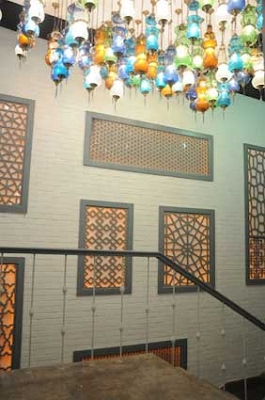 24. Coffee table, by Francesco Caracciolo di Marano and Sam Robin, founders of Robicara company, US http://robicara.com/galleries/pentagon-coffee-table/ Origami, by 'Arseniy K' An instance of origami, simply titled ‘Cairo Tile’, of 2019?, by ‘Arseniy K’ (or Ko, or Koom, he seems to have a variety of name variations), who describes himself as a ‘Paper Alchemist & Origami Designer’. As with his name, much is unclear as to the background here. Seemingly little is known of the artist, save that he appears to be Russian. He is prominent on Flickr and Instagram but does not appear to have a website. His ‘About’ page on Flickr merely gives a link to his Instagram page! His work appears to be strictly ‘mathematical origami’, with a variety of tilings; I did not find any animals, as is often seen in origami. All that accompanies the work, on Flickr, is: I kind of managed to recreate the Cairo tiling, which is type 4 pentagonal tiling, wiki gives more detail on that. And that's one of my few works that has only two-way symmtery [sic]. An open question is to how difficult it is to fold a Cairo tiling. And following on, are there different ways? Ko is aware of the Cairo tiling and directly refers to it as such, as above. I did not contact him. Background As alluded to above, there is nothing more to say; all that is known is as given above! https://www.flickr.com/photos/arseniyko/47747795371/in/faves-32618149@N00/ Origami, by Rob Foord An instance of origami, by Rob (or Robert) Foord, of Gloucestershire (at least of 2005), United Kingdom, an origamist of an international reputation in the field. However, much detail as to Foord and this instance of the Cairo tiling is unclear. I have a reliable account of this appearing in the magazine ‘British Origami Society’ (BOS) 315, April 2019, p. 10. As such, this can be considered as one of the more important instances of origami, as it has appeared in a publication. However, I have not been able to find a picture, and I lack the time and will to join the society to access this publication. Little details on Foord himself are known. His BOS entry merely gives: Rob has been creating designs for many years and his style has obviously changed. He currently works primarily with geometric designs, but this [non-Cairo tiling] is an early creation from the 90s. I have not found other details of Foord than that given above. He does appear to have a social media presence on Facebook and Twitter. As mention is made of the Cairo tiling on the reference, the use of the Cairo tiling must have been purposeful. Among his creations (the BOS database gives 25), are other mathematical instances, and so it appears that Foord has a mathematical interest, albeit to what extent is unclear. I did not contact Foord, notwithstanding that his contact details seem unavailable! Background As alluded to above, all the detail I have is discussed above, and so there is nothing more to add!
https://www.britishorigami.info/society/british-creators/rob-foord/ https://www.giladorigami.com/origami-database/cairo%20tiling 38. Wall Art (1), by Pier Paolo Spinazzè, Italy Pier Paolo Spinazzè, of Italy, an artist and designer who describes himself as a wall designer, makes extensive usage of the Cairo tiling as wall art. He has a website, albeit primarily he is more prominent on social media with Facebook. Oddly, despite an undoubted interest in the Cairo tiling (and indeed other pentagon tilings), although the Cairo connection is acknowledged (although incorrectly, with ‘souks’) this is not detailed as such on his site or Facebook page. As alluded to above, many instances can be seen, of which perhaps the most impressive is that on a Beetle car. Other instances include the company MGM Minerbe and at Veronafiere SpA - Fiera di Verona I contacted Spinazzè, of this 2019 inclusion (with a translation), and previously, but he did not respond to requests for photo permissions and specific background details. Background Pier Paolo Spinazzè, born 1982, has since 1998 dealt with the creation of murals, street art, and graffiti, a passion that he has been able to turn into work. No other relevant detail is given. https://www.facebook.com/pg/ilpierdesign/photos/?ref=page_internal 39. Wall Art (2), by Joseph Warren An instance of wall art, titled ‘CAIRO’ (capitalised as in the original), of which determining the originator and background is not easy, and of which the story is decidedly tiresome to unravel, with scant detail available and much obfuscation. Therefore, the text below is subject to revision. That said, from what little detail there is, or can reasonably be surmised, the designer appears to be Joseph Warren, of the UK, whose name is associated with this on the commercial Saatchi Art site (the world’s leading online art gallery). The art is titled ‘CAIRO No. Eighteen No. 1’ (as according to the number of tiles), of the inflated price (of which Saatchi is renowned for) of £743! It would indeed be interesting to know if this sold! This is described as: Installation: Paint, Enamel, Stencil on Steel. One of a series of unique painted steel artworks. CAIRO artworks are inspired by the tessellating pentagonal tiles found on pavements in the Egyptian capital. Exploring a modern industrial aesthetic, CAIRO pentagons are formed from steel and copper, and given a playful variety of surface treatments. The result is a collection of striking, three-dimensional geometric artworks with endless permutations, and timeless appeal. Fits to wall with magnetic fixings which are included. The wall art is also marketed on the commercial site ‘Image Surgery’ (seemingly related to Saatchi). This is described as: CAIRO Four Nº1 £120.00 (but out of stock as of this 2019 writing) Three-dimensional geometric artwork inspired by the tessellating pentagonal tiles found on pavements in the Egyptian capital. CAIRO is a series of artworks inspired by the tessellating pentagonal tiles found on pavements in the Egyptian capital. Exploring a modern industrial aesthetic, CAIRO pentagons are formed from a variety of materials and given experimental surface treatments. The result is a collection of striking, three-dimensional geometric artworks with endless permutations, and timeless appeal. CAIRO artworks are supplied with concealed magnetic wall fittings for invisible mounting. The designer, presumably Joseph Warren, is thus aware of the Cairo association, and so the use of the Cairo tiling is purposeful here. Apparently, the art was exhibited at London Design Fair, possibly of 2017, from a Joseph Warren Twitter retweet, although details here are next to non-existent; I was not able to find the reference on their site. The Saatchi and Image Surgery sites show different versions. On the Saatchi site, the tiles are coloured curiously, within an overall blue, green and black premise, with single pentagons of blue, green and black and other tiles with arbitrary divisions and circles. The Image Surgery site has single pentagons of blue, red and orange and black and white stripes, with geometric symbols overlaid, of an arrow, equilateral triangle a U shape and circles, all in contrasting colours. Both colouring schemes are arbitrary and baffling! I did not contact Image Surgery, Saatchi Art or Joseph Warren. I judged that Image Surgery and Saatchi Art would not reply, and as for Joseph Warren I simply gave up; he obviously doesn't want to be contacted, detailed below! But why be active on Twitter? It is all most strange. Each to his own... More than most entries here, this entry, of various trying aspects, is undeserving of my time and largesse. But there you go; it is now documented. Background Joseph Warren Warren himself, presumably a designer of sorts, is somewhat of a mystery! The only details given on his Saatchi page are his location, namely Colchester, Essex, United Kingdom! His Twitter page likewise gives no detail and is without contact details! No other relevant detail is given. Saatchi Art Saatchi Art, based in Los Angeles is the world’s leading online art gallery, connecting people with art and artists they love. Saatchi Art offers an unparalleled selection of paintings, drawings, sculpture and photography in a range of prices, and it provides artists from around the world with an expertly curated environment in which to exhibit and sell their work. Image Surgery Limited edition prints, letterpress cards, original artwork and functional homeware designed and produced in England for worldwide art and design insiders. London Design Fair The largest collection of international designers, brands, country pavilions, features and exhibitions in one destination. Located in the creative heart of East London, the London Design Fair is a four-day industry event that brings together 550 exhibitors from 36 countries. https://twitter.com/joseph_lucien (see 30 January 2017 retweet) https://www.saatchiart.com/art/Installation-CAIRO-Eighteen-N-1/6632/3230640/view https://imagesurgery.com/product/cairo-four-no1/ 40. Wall Art (3), of 'Litton Lane' Range An instance of wall art, from the ‘Litton Lane’ range, of two pieces titled ‘Yellow and Brown Wooden Honeycomb Wall Decor’, 28 in. x 28 in, for $57.42, and ‘Rustic Geometric Patterns Wooden Wall Decor in Stained Brown’, 35 in. x 35 in, for $76.00. This is available from The Home Depot, US (the largest home improvement retailer in the United States, although unknown in the UK) and likely other outlets too, as Litton Lane is frequently mentioned, although I have not found more instances of the Cairo tiling art here. This is respectively described as: This square wall art made of Chinese fir wood and MDF features a geometric pattern of interconnected pentagons in black, brown, and gold that complement shabby-chic-inspired design themes. The simple, geometric design and square frame of this wall art blend well with modern-style theme settings. This wall art comes in distressed colors and finishes that add a distinct rustic vibe to interior design themes. and This wall plaque features geometric-shaped accents crafted of fir wood. It features distressed brown, yellow and white finishes that will look great on your rustic and traditional home settings. This decorative piece is enclosed in a sturdy wood frame with a distressed brown finish that can be hung easily on your wall. Oddly, both instances list just three colours, but this is incorrect, each instance has four colours; a light brown and blue colouring were inexplicably omitted here. No mention of the connection as to the Cairo association is made on the Home Depot page and so whether the use of the Cairo tiling is purposeful or accidental, the latter in the sense of a generic pentagon tiling is unknown. Likely the (non-stated) designer is unaware of this association as this would have otherwise have been stated. A curiosity here is that the ‘Yellow and Brown…’ instance has a picture that is not a Cairo tiling as such, as the angles here are clearly not 90°, albeit close. Likely, given the true Cairo tiling, the (non-stated) designer misrepresented the Cairo tiling. Whatever, uncertainties aside, as this nonetheless is very much as a Cairo tiling in appearance, I have thus decided to include, of which I describe as a ‘near miss’. I did not contact The Home Depot, judged likely that from a major conglomerate I would not receive a reply. Background Details Litton Lane is apparently a title given to a wall art range, of which The Home Depot gives 107 items. As such, I was unable to find any more detail on the name. The Home Depot was founded in 1978 and is the largest home improvement retailer in the United States, and indeed the world, supplying tools, construction products, and services. https://www.homedepot.com/p/Litton-Lane-28-in-x-28-in-Yellow-and-Brown-Wooden-Honeycomb-Wall-Decor-98727/302267119 https://www.homedepot.com/p/Litton-Lane-35-in-x-35-in-Rustic-Geometric-Patterns-Wooden-Wall-Decor-in-Stained-Brown-59461/301937063 46. Silkscreen Prints, by Holly Alderman and Arthur Loeb An instance of eight silkscreens, ostensibly by Holly Alderman and Arthur Loeb (1923-2002), although the exact role each has played here is unclear. In short, Alderman is an artist and Arthur Loeb a mathematician, of which they collaborated on this series of artworks, in 1983, whilst both were at Harvard University. Alderman was Loeb's assistant at Harvard for three years (1978-1981). I suspect that Alderman did the artwork, influenced by Loeb, who has a particular interest in pentagon tilings, among other tiling matters. A chapter in his book discusses them and shows an unaccredited Cairo tiling [1]. Background details in a generalised sense are detailed on the Rhode Island School of Design (RSID) site, albeit no mention is made here, or indeed elsewhere, of the Cairo tiling association and so whether the use of the Cairo tiling is purposeful or accidental, the latter in the sense of a generic pentagon tiling is unknown. However, as 1983 was still relatively early since the first recorded attribution (James Dunn, in 1971, with only five references up to 1983, albeit some popular that he should have been aware of), it may very well be that Alderman and Loeb were unfamiliar with the association. Alderman and Loeb collaborated on other mathematical silkscreens that present all infinite tessellating symmetry systems possible in the plane, of which the Cairo tiling played a prominent part, appearing eight times, as wireframes, in a variety of colourings and presentations. These can all be seen on the RSID site, see sections 5 and 6. Each print is described in a most simple manner, without any mathematics, as exemplified by the first instance: Loeb Silk-screen print. Holly Compton Alderman, Harvard University, Arthur Loeb, Harvard University. Exhibition Date 1983. Description cream paper, orange and double pink honeycomb overlay. These tessellations were exhibited internationally, of which the RSID site states: 24 limited editions exhibited in the Design Science Studio first in 1983; at the International Symmetry Congress at the Hungarian National Gallery in 1984; and, at Currier House, Harvard in 1990. Whether this includes the Cairo tiling instances is unclear. As alluded to above, the angles and side lengths are not given. However, it would appear to be of an equilateral pentagon. I contacted Alderman in 2014, but she did not reply. I did not contact Loeb, his 2002 passing preceding my more recent exhaustive study of the tiling, beginning in 2009. Background Details Holly Alderman Alderan, of Boston, US is a distinguished graphic designer, producer of art decor collections, unique Hamlen Chinoiserie and French Dufour scenic wallpaper and prints. She designed covers for the Phonebook local telephone books and wrote feature profiles for community newspapers. She was first appointed as a teaching assistant in art at the young age of 16. She is still active in art circles to the present day (2019). Arthur Loeb Arthur Lee Loeb (1923-2002), was a Dutch scientist and crystallographer. He arrived at the U.S. during World War II, completed his undergraduate studies at the University of Pennsylvania in 1944, and his Ph.D. in Chemical Physics at Harvard University in 1949. Loeb taught at the Massachusetts Institute of Technology in the early part of his career. He later taught at Harvard, where he was a senior lecturer in the Visual and Environmental Studies Department. His interest in ‘Visual Mathematics’ and ‘Design Science’, led to lifelong collaboration with innovators such as R. Buckminster Fuller and M. C. Escher. Loeb was a founder and first Vice-President of the International Society for the Interdisciplinary Study of Symmetry (ISIS-Symmetry). The Rhode Island School of Design carries a collection on design science in his name. He is buried at Mount Auburn Cemetery in Cambridge, Massachusetts, and his grave contains the inscription ‘Beloved teacher, scientist & musician’. [1] Loeb, Arthur. Concepts & Images Visual Mathematics. Design Science Collection. Birkhäuser Boston 1993. Especially see Chapter 9, pp. 89-100 ‘Pentagonal Tessellations’, featuring an unaccredited Cairo tiling, https://digitalcommons.risd.edu/loeb_symmetryportfolio/ Crossword Puzzles Crossword Puzzles, in The Listener Two instances of crossword puzzles, by ‘Croton’, in the UK weekly magazine The Listener, titled ‘Hexa-Pentagonal I’, puzzle 1128 of 13 December 1951 and ‘Hexa-Pentagonal II’, puzzle 1251, of 22 April 1954. Puzzlers were invited to send their solution in for a prize. Research is hampered by not having direct access to the source, of which the references are only available for institutional access, with GALE, and explicitly excludes individual subscriptions. Does anyone have access to this archive to clarify matters? That said, all is not lost! Puzzle 1128 (as a facsimile?) is repeated in a general book on the crosswords by Millington [1], with The Listener and Croton sources given. This is accompanied with further relatively lengthy explanatory text, beginning with ‘The diagram of 64 pentagons…’ but it is not clear if this is from The Listener or is Millington’s commentary. Both clues and the solution are given. It is also shown, suitably redrawn, in Mottershead [2], with mention of Croton, albeit without The Listener source being credited. It is also mentioned in passing in Rollett [3], below (albeit without any significance per se), with The Listener credited but no mention of the Croton reference: 2530. A pentagonal tessellation. My colleague Mr. R. C. Lyness noticed this pattern on the floor of a school in Germany. It has also appeared in a crossword puzzle in The Listener. It might be used in "patchwork " as a change from the traditional hexagon. I have not seen puzzle 1251, only being aware of it on the dedicated fan crossword puzzle site of The Listener, run by Roger Phillips. Each puzzle is described on the site as follows: Crossword No. 1128: Hexa-Pentagonal by Croton Symmetry: 180 degree + mirror Size: 64 cells Theme: Grid comprises two overlapping hexagonal lattices such that each hexagon is divided into four pentagons, and contains a 4-letter word read clockwise; four 8-letter words are formed along the edges. Prizewinners: J Brasier (Sibford Gower), F E Spurrell (Ruislip), J H Bingham (Sheffield) Crossword No. 1251: Hexa-Pentagonal — II by Croton Symmetry: 90 degree + mirror Size: 100 cells Theme: Grid comprises two overlapping hexagonal lattices such that each hexagon is divided into four pentagons, and contains a 4-letter word read clockwise; four 10-letter words are formed along the edges. Prizewinners: P H Scott (Maidenhead), J M Doulton (Orpington), W F Kibble (Cheam)
Of some not inconsiderable interest is to who exactly is Croton. Given the early date for its appearance, of just the thirteenth such instance, this is thus of more interest than of latter-day concerns. Of possible interest concerning the investigation is that he also set two other puzzles, also of a mathematical theme, between the two Cairo instances, ostensibly on Pythagoras matters. However, I have also not seen these. He seems to have set puzzles for a brief period of four years, once a year, from 1951-1954. Setters of the puzzle invariably operated under a pseudonym, and so this identification of him was standard practice. It is not clear if the compilers real name was also given, or on occasion, at the time. The Listener crossword site has a dedicated setters section, of which this has a page where the compiler’s names are given, where known, but unfortunately ‘Croton’ is one of the few entries for which a name is not available! I contacted Roger Phillips, Co-editor, of The Listener Crossword site for further details (in 2012), of which although I received a reply he was unable to tell me who he or she was; the detail was simply not there. Given the passage of time, it is likely he or she is now no longer alive. With such a paucity of detail, finding Croton is thus extremely difficult, if not next to impossible. Indeed, there is nothing to go on beyond an obvious mathematical interest and the pseudonym! Croton (now southern Italy) is of course geographically famous with a Pythagoras association. But how to progress the investigation with still such a broad base? Are you there, Croton?
Given as this predates the instigation of the named Cairo association, there is thus naturally no mention made. As to the diagram and puzzle itself, with a presumed facsimile, this is relatively crudely hand-drawn, and furthermore of a small scale, that it is not clear as to the exact pentagon intended. However, it is possibly meant to be equilateral. Interestingly, this, in the title and/or Millington, see above, notes the pentagon-hexagon interpretation/arrangement. Great play in the literature is made of The Listener having themed puzzles, although here, from the clues, this does not appear to be so in this case. Background The Listener was a weekly magazine established by the BBC in January 1929 which ceased publication in 1991. The entire digitised archive was made available for purchase online to libraries, educational and research institutions in 2011. It was first published on 16 January 1929, under the editorship of Richard S. Lambert, and was developed as a medium of record for the reproduction of broadcast talks. It also previewed major literary and musical broadcasts, reviewed new books, and printed a selected list of the more intellectual broadcasts for the coming week. Its published aim was to be ‘a medium for intelligent reception of broadcast programmes by way of amplification and explanation of those features which cannot now be dealt with in the editorial columns of the Radio Times’. The title reflected the fact that at the time the BBC broadcast via radio only. The Listener crossword puzzle, introduced in 1930, is generally regarded as the most difficult cryptic crossword to appear in a national weekly. It survived the closure of The Listener and now appears in The Times on a Saturday, along with other puzzles and game articles on the last four pages of the Saturday Review section. Of note is that unusual grids appeared from very early in the series. It took approximately 15 years before some of the more standard non-orthogonal grids appeared. No. 855 (1946) introduced the use of an hexagonal (“honeycomb”) grid. No. 1015 (1949) was the first with a circular grid. Both of these proved immediately popular with setters and have remained so ever since. After the war, the Listener Crossword evolved significantly in terms of fairness and editorial quality, but continued to feature the most challenging thematic cryptic crosswords. It acquired a reputation as one of the best crossword series and became a cultural institution in Britain. No other crossword series has been parodied both by Punch and the Not the Nine O’Clock News team. References Primary: Croton, The Listener, 13 December 1951, puzzle 1128 Hexa-Pentagonal I Croton, The Listener, 22 April 1954, puzzle 1251 Hexa-Pentagonal II Secondary: Millington, Roger. The Strange World of the Crossword Puzzle. M & J Hobbs in association with Michael Joseph, 1974 Mottershead, Lorraine. Sources of Mathematical Discovery. Basil Blackwell, 1977. Rollett, A. P. ‘A pentagonal tessellation’. Mathematical Notes 2530. Mathematical Gazette, Vol. 39, No. 329, September 1955, p. 209. As an aside, Rollett also shows the Cairo tiling in Mathematical Models, with H. M. Cundy. The Listener Crossword Site (independent of the magazine) http://www.listenercrossword.com/ (Home page) http://www.listenercrossword.com/Years/Puzzles/L1/L11/L1128.html (Background details on puzzle 1128) http://www.listenercrossword.com/Years/Puzzles/L1/L12/L1251.html (Background details on puzzle 1251) http://www.listenercrossword.com/Setters/C/Croton.html (On Croton’s four puzzles) http://www.listenercrossword.com/HTML/History02.html (A history, in the context of grids and clue formats) http://www.listenercrossword.com/HTML/Reference03.html (Generic puzzle sources, including Millington) Crossword Puzzle, Cairo-Muster-Rätsel An instance of a German crossword puzzle, titled ‘Cairo-Muster-Rätsel’, which translates as ‘Cairo Pattern Puzzles’, drawn to my attention by Ulrich Seidel, of Germany. However, beyond these bare details, little more is known. The journal/newspaper and year are not stated. I received this in October 2017. © Ulrich SeidelAs mention is made of the Cairo tiling on the page, the use of the Cairo tiling is thus purposeful. Background In effect there is nothing more to add, all the detail I have is as above! Acknowledgement Ulrich Seidel, for drawing this puzzle to my attention. Page History 2014 Quilting/Patchwork, Josee added 2 October. 2015 Escher-like Cairo tilings by Alain Nicolas added 9 November. Tamara Bistro Restaurant added 11 December. 2016 Chair, 'Bretzel Love’ Café added 8 September. 2017 Chair, Monsieur Meuble, text and picture added 27 July. Folded paper, by Ron Resch text and picture added 26 October. Marquetry, by Helio and Co, London, UK text added 31 October. Coffee table by Monzer Hammoud, text and pictures added 3 November. Format revised, as the scope was a little too broad, with three in situ Cairo tiling aspects included (Attraction, Manufacturer, Downtown sighting), now better judged placed elsewhere as entities in their own right.10 November 2017. Coffee Table, by Francesco Caracciolo di Marano and Sam Robin, text and pictures added 14 November. Wall Installation, at the Arndale Centre, Manchester, UK, text and picture added 15 November. REMOVED 2019. Acoustic Walls, by Kamilla Lang Hermansen, of Norway, text added 16 November. Shelving Unit, by Alexander Pincus, text and picture added 30 November. Origami, by John Szinger, text and picture added 6 December. Origami, by David Mitchell, text and picture added 19 December. 2018 Escher-like fish puzzle, by Angie Leslie, text and pictures added 3 January. 2019 Ceiling, Davos Congress Centre, Switzerland, added as ceiling panel, (of an architectural dual placing), 7 October. Ceiling, Ghelamco Arena, Belgium added as ceiling panel (of an architectural dual placing), 10 October. Wall Panels, Fluffo, Poland, text, pictures and links added 14 October (new entry). Wall Art, Pier Paolo Spinazzè, Italy, text and links added 16 October (new entry). Wall Art, Joseph Warren, UK, text, pictures and links added 17 October (new entry). Wall Art, Litton Lane, US, Wall Art, text, pictures and links added 18 October (new entry). Silkscreens, Holly Alderman and Arthur Loeb, text, picture and links added 1 November (new entry). Bookshelf, Alfredo Häberli, text, picture and links added 4 November (new entry). Bookshelf, Alix Welter, text, and links added 5 November (new entry). 'Conceptual Spatial Puzzle', Mark Cabrinha, text, pictures and links added 7 November (new entry). Table, by Andreas Hopf. Text addition to existing 2013 entry. 3D Wall Panel and Light Box, of individual entries, Outer Art Co, text, picture and links added 14 November (new entries). Fibre Arts, Patchwork/Quilting. The book Liesels Fünfecke by Hilde Klatt and Liesel Niesner text, picture and links added 14 November (new entry) Fibre Arts, Patchwork/Quilting, by Josée Carrier. Wholesale revision and expansion to an existing 2014 entry, of just two lines and a single picture! 19 November 2019 (Effectively a new entry). Fibre Arts, Patchwork/Quilting and Origami (dual placing) by Christiane Bettens, aka Mélisande. Text, pictures and links added 20 November (new entry). Fibre Arts, Quilting, by Lynn Kline, of 'Monkey Needle', US. Text, and links added 21 November. (new entry). Fibre Arts, Quilting, by Sami Casanova, US. Text and links added 22 November (new entry). Fibre Arts, Quilting, by Pat Yamin, of 'Come Quilt With Me', US. Text, picture and link added 25 November. (new entry). Fibre Arts, English Paper Piecing, by Paper Pieces, US. Text, picture and link added 26 November (new entry). Fibre Arts, Quilting, by Dorothea Lutgerink, the Netherlands. Text, picture and link added 27 November (new entry). Fibre Arts, Crochet, by Sara Palacios, Argentina. Text, picture and link added 28 November (new entry). Fibre Arts, Weave, by Harry Nisbet, UK. Text and picture added 29 November (new entry). Origami, Arseniy K, Russia? Text and link added 2 December (new entry). Origami, by Rob Foord, UK. Text and links added 6 December (new entry). Crossword Puzzle, by 'Croton', in The Listener. Text, picture and links added 9 December (new entry). Crossword Puzzle, titled ‘Cairo-Muster-Rätsel’. Text, picture and links added 10 December (new entry). Paper Arts, Origami, Eric Gjerde, US. Text, picture and links added 18 December (new entry). Paper Arts, Origami, Carlos Natan López Nazario, Mexico. Text and links added 19 December (new entry). Jali, by Simon Ray. Text, picture and link added 23 December (new entry). Jali, by 'Olx of Quickr'. Text, picture and link added 24 December (new entry). Jali, by Metropolitan Museum of Art. Text, pictures and link added 27 December (new entry). Page Creations There have been so many page creations and revisions for what is this now broad 'Miscellaneous 1' grouping, under a variety of names and inclusions that its history is lost. For what it is worth, I previously recorded versions of 2012 and 2014. Page Created: 18 June 2012. Revised and enlarged subsequently, out of all recognition. New, overall page created 7 August 2014, for a more streamlined section, assembling previous single pages as a miscellaneous entity Page created as a subset of the Cairo tiling ('As Miscellaneous 1') 6 December 2019, with existing appropriate entries (as detailed above) on a generic 'Miscellaneous' page (which had become somewhat unwieldy) duly 'moved' here. Or more exactly, for reasons of convenience and speed, I copied the page, and deleted non-appropriate entries, before continuing to add new entries from this date. The effective history seemingly dates back to 2014, of which I lack the will to document. |
Cairo Tiling >
